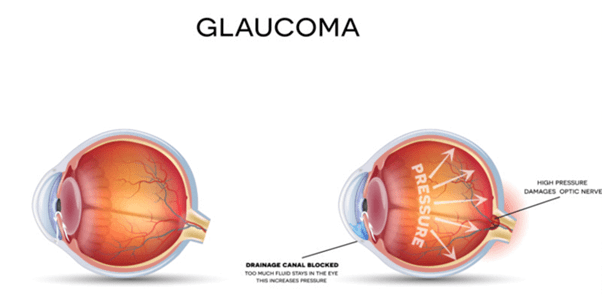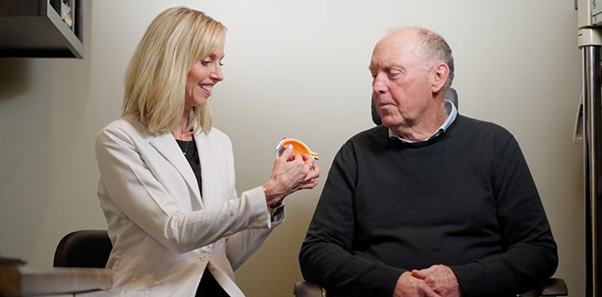It’s estimated that around 3 million Americans are currently living with glaucoma. With this disease still on the rise, it is now the second leading cause of blindness worldwide. We will look deeper into what glaucoma is, answer the common question ‘how does it cause vision loss?’, uncover symptoms and discuss the types of glaucoma and how it is detected.
What Is Glaucoma?

Glaucoma is a complex group of eye conditions caused by damage to the optic nerve. This is often due to a build-up of pressure in your eye, although it can sometimes occur when the eye pressure is normal.
Elevated eye pressure happens because of excess fluid in the eye. This fluid usually drains through the tissue between the iris and the cornea; however, the intraocular pressure may increase when the eye develops too much fluid or if it doesn’t drain properly. The increased pressure in the eye causes damage to the optic nerve, creating blind spots in your peripheral (side) vision.
Different types of glaucoma include open-angle, acute angle-closure, normal-tension, glaucoma in children, and pigmentary glaucoma. Among these types, open-angle glaucoma is the most common, and it affects up to 90% of glaucoma patients in the US.
Who Can Be Affected By Glaucoma?
There are several risk factors to consider regarding glaucoma, including age, family history, and ethnicity. Individuals over 60 are particularly susceptible, so we recommend having annual eye examinations for early detection. African Americans face a higher risk, too, being six to eight times more likely to develop glaucoma than Caucasians.
Additionally, if you have medical conditions such as diabetes, migraines, high blood pressure, extreme near-sightedness or farsightedness, previous eye injuries, or are taking corticosteroid medicines for prolonged periods, you are also at risk of developing glaucoma.
Symptoms Of Glaucoma

In the early stages, glaucoma does not have any obvious symptoms, which is why many people don’t realize they have it. Once the disease progresses, symptoms tend to vary based on the stage and type of glaucoma. The two major types of glaucoma, open-angle glaucoma and acute-closure glaucoma, usually present with different symptoms.
Gradual symptoms of open-angle glaucoma can include:
· Gradual, patchy blind spots in your side vision (peripheral vision)
· Loss of central vision if the disease progresses
Sudden symptoms of acute angle-closure glaucoma include:
· Headaches
· Severe eye pain
· Nausea and vomiting
· Blurry vision
· Seeing rainbow-colored halos when looking at lights
· Eye redness and pain
There are no symptoms in both types at first, so you often don’t know you have it until the damage is severe and has impacted your vision. Acute-closure glaucoma is considered a medical emergency and needs immediate attention.
How Can You Prevent Glaucoma?

Attending regular eye exams will allow us to detect any conditions before you may notice them. Catching and detecting glaucoma at this early stage will protect your vision from further deterioration and control or slow its progression.
OCT (Optical Coherence Tomography), a non-invasive, state-of-the-art diagnostic scan, and a visual field test can show signs of glaucoma in the early stages. In fact, this allows us to detect disease up to 5 years earlier than a regular eye exam that uses traditional retinal photography methods alone.
Knowing if your family has a history of glaucoma is key as well. You’re more likely to develop glaucoma if a close family member, like a parent or sibling, has it. If you know you have a family history, it’s best to contact us so we can schedule you for an eye exam for peace of mind.
Get In Contact
Our office has some of the best eye doctors in Quincy, IL, trained to help detect, treat, and manage all kinds of eye diseases. Alongside our latest technology, we use our years of experience and knowledge to ensure early detection, timely treatment, and ongoing management of glaucoma. If you have any concerns about your vision or want to learn more about glaucoma, contact us today.
